Facial redness can be noisy — it shouts for attention even when you don’t want it to. Fortunately, many causes of redness respond very well to gentle, consistent, natural care. This guide walks through what causes redness, how to calm it right now, and practical long-term habits to keep your skin steady and comfortable — without complicated products or harsh treatments. Whether your redness flares from weather, sensitivity, rosacea, or stress, you’ll find evidence-based, skin-kind tactics and step-by-step routines you can use immediately.
Understanding Facial Redness: Why Your Skin Reacts and How to Fix It Naturally
What redness really is:
At its simplest, redness is increased blood flow near the skin surface (vasodilation) plus inflammatory signaling. It’s the skin’s way of saying “something’s not quite right.” That “something” ranges from temporary irritation (scrubbed too hard) to chronic conditions (rosacea, eczema).
Key biological points (short & practical):
- Barrier disruption (loss of lipids and moisture) → irritants penetrate more easily → inflammation → redness.
- Immune response: immune cells in skin release inflammatory mediators that cause blood vessels to widen.
- Neurovascular reactivity: nerves in sensitive skin can overreact to stimuli (temperature, spicy food, alcohol), triggering flushing.
- Microbial imbalance: overgrowth of certain microbes (e.g., Malassezia or skin bacteria) can trigger inflammation for some people.
Natural approach to “fix” it:
- Repair the barrier — focus on gentle cleansers, humectants (glycerin, hyaluronic), and barrier lipids (ceramides, fatty acids).
- Reduce inflammation — use natural anti-inflammatories (green tea, aloe, oatmeal, centella).
- Avoid triggers — protect from extremes (hot showers, sun), fragrance, harsh exfoliation.
- Support overall health — hydration, balanced diet, sleep and stress control.
Start with barrier repair and gentle avoidance of triggers — those two moves alone often produce the largest improvements.
Common Causes of Skin Redness You Might Be Overlooking
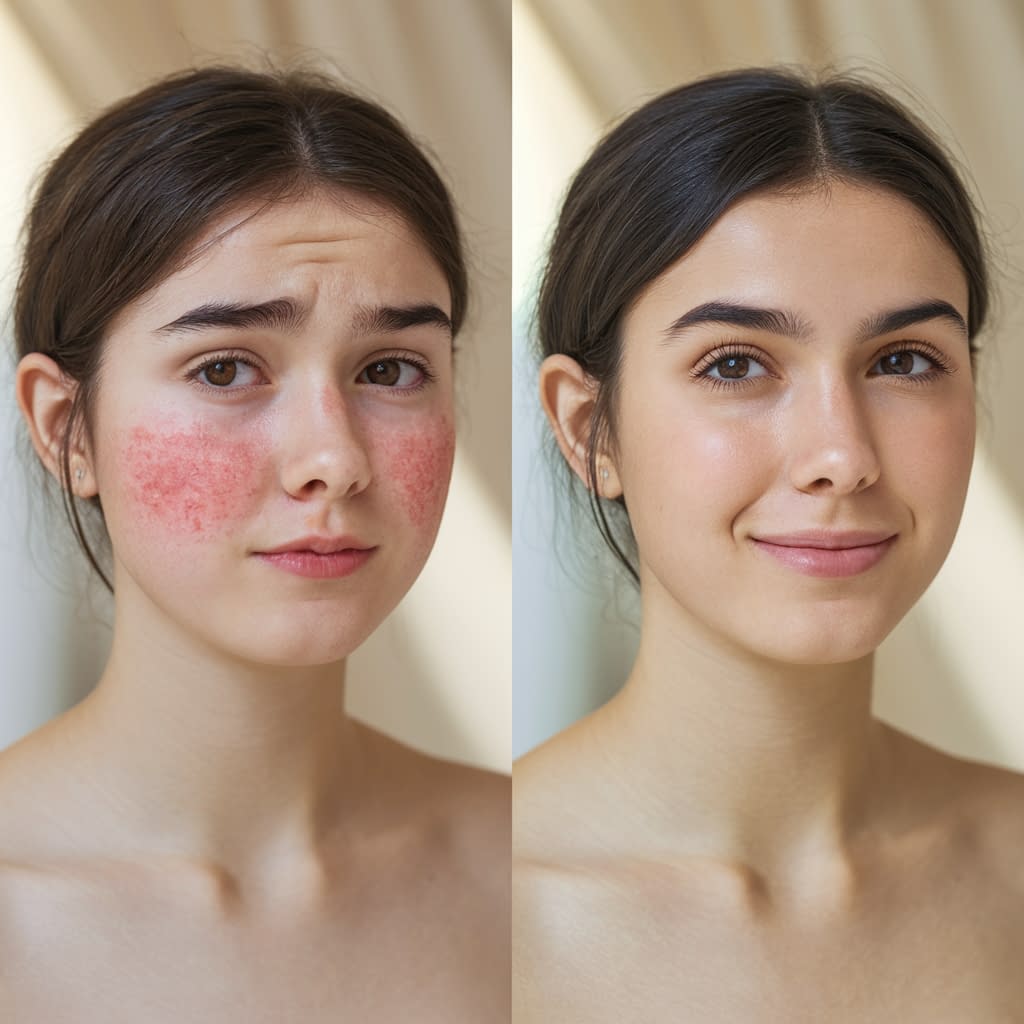
You probably know the obvious suspects (sun, wind, harsh products). Here are the things people commonly miss:
- Hidden irritants in “natural” products: essential oils, botanical extracts, citrus-derived ingredients — natural ≠ gentle.
- Over-exfoliation: daily scrubs or high-frequency chemical peels thin the barrier and create persistent redness.
- Hot water and steam: showers, saunas, and even hot drinks can provoke flushing in sensitive skin.
- Wrong sunscreen or SPF application: poor rinse or abrasive physical sunscreens (if not finely milled) can rub and irritate.
- Temperature swings: going from cold outside to a warm room triggers vascular reactivity.
- Food and drink triggers: alcohol, hot/spicy foods, and very hot drinks cause transient flushing and can worsen chronic redness in susceptible people.
- Medications & topical steroids: long-term topical steroid use can cause steroid-induced rosacea or rebound redness.
- Underlying conditions: rosacea, eczema, seborrheic dermatitis, lupus — all can cause redness and need targeted care.
Quick checklist: If redness persists despite gentle care, check for: new product starts, frequent exfoliation, steroid use, and daily triggers (alcohol, hot showers). These are fixable and should be the first changes to test.
Top Triggers That Worsen Facial Irritation (and How to Avoid Them)
Here are the most common triggers and practical avoidance strategies:
Trigger: Harsh surfactants & fragranced skincare
- Avoid: sodium lauryl sulfates, denatured alcohol high on the ingredient list, fragrance/parfum, and essential oils used at full strength.
- Do instead: choose fragrance-free, sulfate-free cleansers with simple ingredient lists.
Trigger: Over-exfoliating (mechanical & chemical)
- Avoid: daily scrubs, aggressive brushes, and using acids/retinols together.
- Do instead: limit AHA/BHA to 1–2× weekly (low concentrations) and use physical exfoliation only 1× week with a very soft tool.
Trigger: Hot water, steam, and saunas
- Avoid: hot showers and steaming towels directly on the face during flare-ups.
- Do instead: use lukewarm water and cool compresses to calm redness.
Trigger: Direct sun exposure
- Avoid: skipping SPF or relying on cloud cover.
- Do instead: broad-spectrum SPF 30+ daily, wide-brim hats, and seeking shade.
Trigger: Spicy food, alcohol, and extreme temperatures
- Avoid: heavy intake on days you want calm skin.
- Do instead: note personal triggers in a simple diary and reduce consumption before important events.
Trigger: Stress & poor sleep
- Avoid: chronic stress build-up.
- Do instead: short daily stress practices (breathing, 10 minutes walking) to reduce neurogenic flushing.
Best Natural Ingredients to Calm and Soothe Red, Sensitive Skin
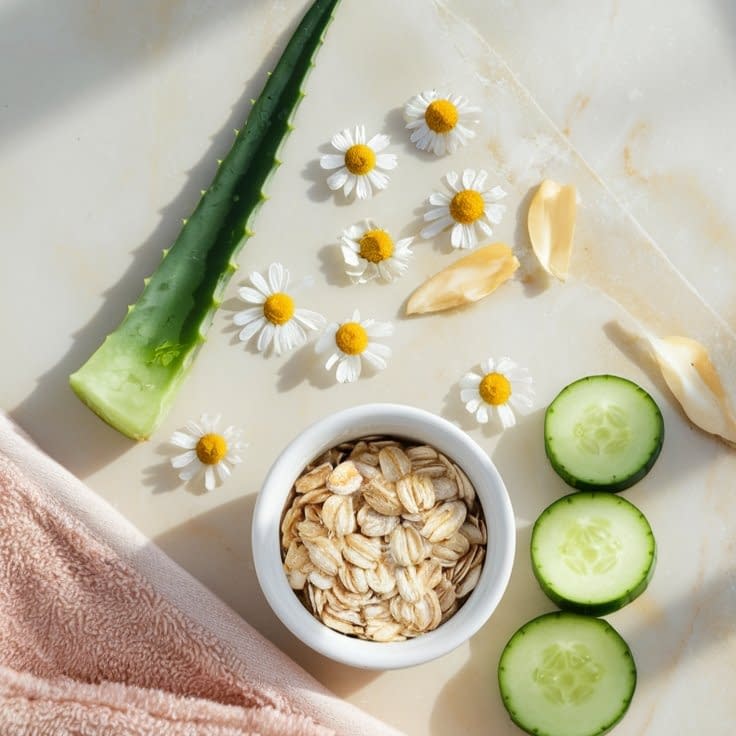
These ingredients are well-tolerated and backed by soothing, anti-inflammatory activity.
1. Centella asiatica (cica)
- Soothes, supports barrier repair, and reduces redness. Look for products labeled “centella/asiatica.”
2. Green tea (EGCG)
- Powerful antioxidant and anti-inflammatory. Use in serums or as a cooled compress.
3. Aloe vera
- Cooling, anti-inflammatory, and hydrating. Use pure gel (Aloe barbadensis) for topical soothing.
4. Colloidal oatmeal
- Excellent for itching and barrier repair — used in masks and cleansers.
5. Niacinamide (vitamin B3)
- Strengthens the barrier, reduces redness, and is gentle (start at 2–5% concentration).
6. Hyaluronic acid & glycerin (humectants)
- Draw water into skin and improve plumpness without oiliness.
7. Chamomile & calendula (carefully)
- Calendula and chamomile have anti-inflammatory properties — patch test first (some people are sensitive).
8. Squalane
- Lightweight emollient that restores lipids without clogging.
Safety note: Even natural ingredients can irritate. Always patch-test (inner forearm) 24–48 hours before full-face use.
Gentle Skincare Routine for Redness-Prone Skin: Step-by-Step Guide
A simple routine that calms redness, rebuilds the barrier, and reduces irritation risk.
Morning Routine (5 minutes)
- Rinse or cleanse gently
- Use a cream or micellar cleanser. Massage with fingertips for 20–30 seconds. Rinse with lukewarm water. Pat dry.
- Example base: glycerin-based or oat cleanser.
- Antioxidant step (optional)
- Apply 2–3 drops of a gentle vitamin C derivative if tolerated (aspirin-sensitive or rosacea skin may skip). Alternatively use a niacinamide serum 2–5%.
- Hydration
- Apply a hyaluronic acid or glycerin serum on damp skin.
- Barrier moisturizer
- Use a ceramide-rich, fragrance-free moisturizer. For daytime pick a lighter lotion; for dry skin a cream.
- Sunscreen
- Apply a mineral (zinc oxide/titanium dioxide) or mild chemical broad-spectrum SPF 30+ and reapply when needed.
Evening Routine (7–10 minutes)
- Cleanse (gentle) — repeat as morning. If you wear heavy sunscreen or makeup, double-cleanse using a gentle oil/cream cleanser first, then the regular cleanser.
- Target treatment (if using):
- If you use prescription meds — follow your provider. Otherwise, apply niacinamide or a calming serum. If you use retinoids, start slowly (1–2× weekly) and buffer with moisturizer.
- Moisturize — choose a richer cream at night with ceramides, squalane, or fatty acids. Consider a thin occlusive (petrolatum) on very dry patches.
- Spot care — use aloe or a cooled green-tea compress on active irritation.
Weekly extras
- 1× weekly: very gentle exfoliation (optional) with a low-concentration lactic acid or a soft enzyme mask.
- 2× weekly: barrier-repair masks (oatmeal, aloe, plain yogurt for short times) — recipes below.
Step-by-step daily mantra: Cleanse gently → hydrate → rebuild → protect.
DIY Face Masks and Natural Remedies That Reduce Redness Fast
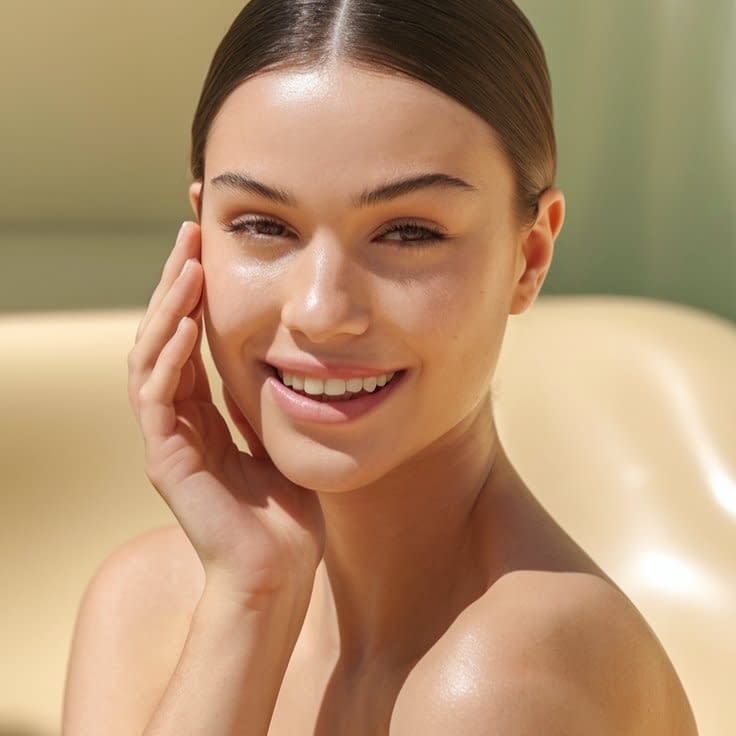
All recipes include a patch-test step before face use.
Cold Green-Tea Compress — quick calm (3 minutes)
- Why: EGCG reduces inflammation; cool temperature constricts vessels.
- Make it: Brew 1 green tea bag in ½ cup hot water, chill until cool. Soak cotton pads or a soft cloth and apply to face for 3–6 minutes. Repeat once if needed.
Soothing Oatmeal & Yogurt Mask (10–15 minutes)
- Why: Oatmeal calms itching; yogurt provides mild lactic acid and cooling.
- Ingredients: 1 tbsp colloidal oatmeal + 1 tbsp plain yogurt (unsweetened).
- Method: Mix into a paste, apply to face for 10–15 minutes, rinse with lukewarm water. Pat dry and moisturize. Use 1–2× weekly.
Aloe + Honey Quick Soother (10 minutes)
- Why: Aloe calms; honey is antimicrobial and a humectant.
- Ingredients: 1 tbsp pure aloe vera gel + 1 tsp raw honey.
- Method: Apply thin layer 10 minutes, rinse off. Not for people allergic to bee products.
Cooling Cucumber & Aloe Blend (5–10 minutes)
- Ingredients: 2 slices cucumber blended with 1 tbsp aloe gel.
- Method: Strain if needed, apply liquid as compress for 5–10 minutes. Great for puffiness and transient redness.
Baking Soda? — avoid for sensitive skin
- Note: avoid alkaline irritants (baking soda) — they disrupt barrier pH and worsen redness.
How to use DIY safely: patch test 24–48 hours, keep masks short (10–15 min), rinse gently, moisturize after.l
Best Oils and Herbal Extracts for Cooling and Calming Irritated Skin
Good options (gentle, non-comedogenic choices):
- Jojoba oil: closely mimics sebum, non-comedogenic, good for skin repair. Use neat for most.
- Squalane (plant-derived): light, non-greasy emollient that soothes and seals.
- Argan oil (small amounts): rich in vitamin E and fatty acids — use sparingly if prone to breakouts.
- Rosehip oil: high in linoleic/linolenic acids and vitamin A precursors — great for barrier and texture but patch test for sensitivity.
- Chamomile extract: anti-inflammatory, but can irritate a small subset — patch test.
- Licorice root extract (glabridin): brightening and anti-inflammatory; useful for redness-prone pigment issues.
How to use oils safely (step-by-step):
- Patch test first.
- Apply a single drop to fingertip and press into skin after moisturizer (skin-first method) or mix 1–2 drops into your cream.
- For very reactive skin, dilute essential oils heavily or avoid them; essential oils are common irritants.
- Use oils at night if you’re acne-prone to see how skin reacts.
Foods and Drinks That Help Heal Redness from the Inside Out
Inflammation shows on skin — diet matters.
Eat more of these:
- Omega-3 rich foods: fatty fish, flaxseeds, walnuts — reduce systemic inflammation.
- Colorful fruits & vegetables: berries, leafy greens, peppers — antioxidants fight oxidative stress.
- Fermented foods or probiotics: yogurt, kefir, sauerkraut — support gut-skin axis (microbiome).
- Zinc-rich foods: pumpkin seeds, legumes, lean meat — support repair and reduce inflammation.
- Polyphenol foods: green tea, dark chocolate (small amounts), turmeric — anti-inflammatory.
Limit these:
- High sugar & refined carbs — they increase inflammation and glycation.
- Excess alcohol and spicy food (if you trigger flushes) — reduce for calmer skin.
A week-long anti-redness meal hint: breakfast with yogurt + berries + chia, lunch leafy salad with salmon + olive oil, snack green tea and nuts, dinner turmeric-ginger soup with plenty of veg.
Hydration Habits That Keep Your Skin Balanced and Less Reactive
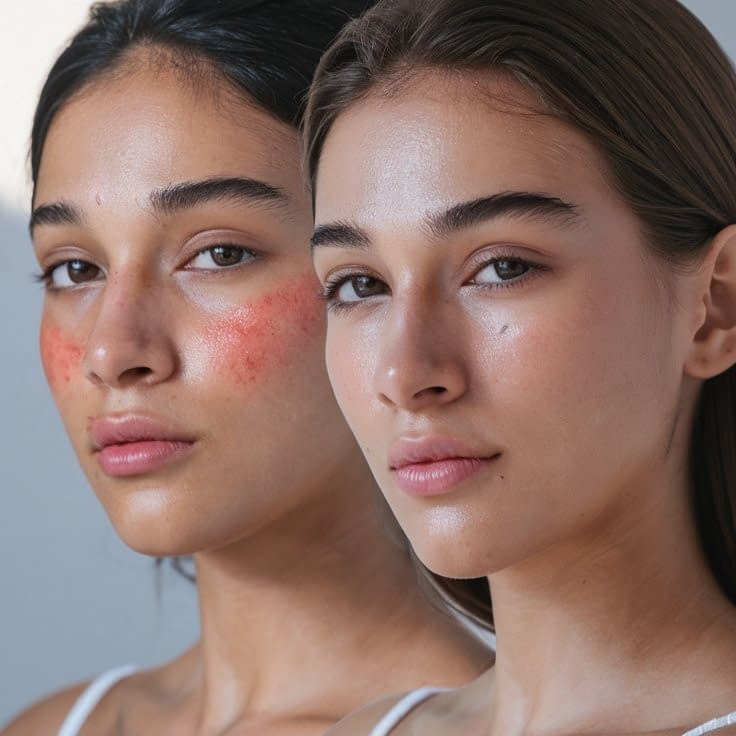
Hydration = foundation.
Drink smart: aim for steady water intake (individual needs vary) — sips throughout the day beat gulping. Add electrolytes in hot weather or after heavy exercise.
Topical hydration tips:
- Layer humectants on damp skin: apply hyaluronic acid or glycerin serums to damp skin, then follow with moisturizer to lock in moisture.
- Use occlusives at night for severe dryness: small amount of petrolatum over moisturizer on very dry patches prevents TEWL overnight.
- Humidify dry environments: a bedroom humidifier in winter keeps skin from drying out.
Avoid over-hydration myths: drinking enormous amounts of water won’t instantly clear redness — hydration works best paired with barrier care.
How Stress, Sleep, and Lifestyle Choices Affect Skin Redness
Stress and sleep alter skin physiology:
- Stress → cortisol spikes → weakens barrier and increases inflammation.
- Poor sleep reduces cell repair and increases redness and sallow tone.
- Circadian rhythm: skin repairs best during deep sleep; inconsistent schedules cause chronic stress.
Actionable habits (daily):
- Short stress breaks: 5–10 minutes of breathing or walking midday lowers reactivity.
- Sleep hygiene: 7–8 hours most nights; regular bedtime supports skin repair.
- Moderate exercise: improves microcirculation but avoid intense heat workouts if you flush easily; cool down promptly.
- Digital detox before bed: reduce late screens for better sleep quality (blue light can disrupt circadian rhythm).
Natural Products Worth Trying for Sensitive and Reactive Skin
Look for these product types/ingredients when buying ready-made skincare:
- Cleanser: glycerin or oat-based, sulfate-free.
- Toner/essence: glycerin or hydrating low-alcohol formulas; green tea or centella containing for calming.
- Serum: niacinamide (2–5%), hyaluronic acid for hydration.
- Moisturizer: ceramide + fatty acids + minimal fragrance.
- Mask: colloidal oatmeal masks or aloe gels for emergency cooling.
- Sunscreen: mineral (zinc oxide) physical sunscreens are often less irritating. Choose non-whitening tinted formulas for aesthetics.
How to choose: short ingredient lists, fragrance-free, and products labeled for “sensitive” skin are good starting points. Patch test everything.
Avoid These Common Skincare Mistakes That Make Redness Worse
Stop these habits now:
- Rubbing or scrubbing vigorously (face cloths, brushes).
- Layering too many actives (retinol + strong AHA + strong vitamin C all at once). Introduce one at a time.
- Using hot water on face.
- Skipping SPF — UV light is a major inflammatory trigger.
- Overusing steroid creams without medical supervision — they can cause rebound redness.
- Not patch-testing new products — many reactions are avoidable.
When to See a Dermatologist About Persistent Redness or Rosacea
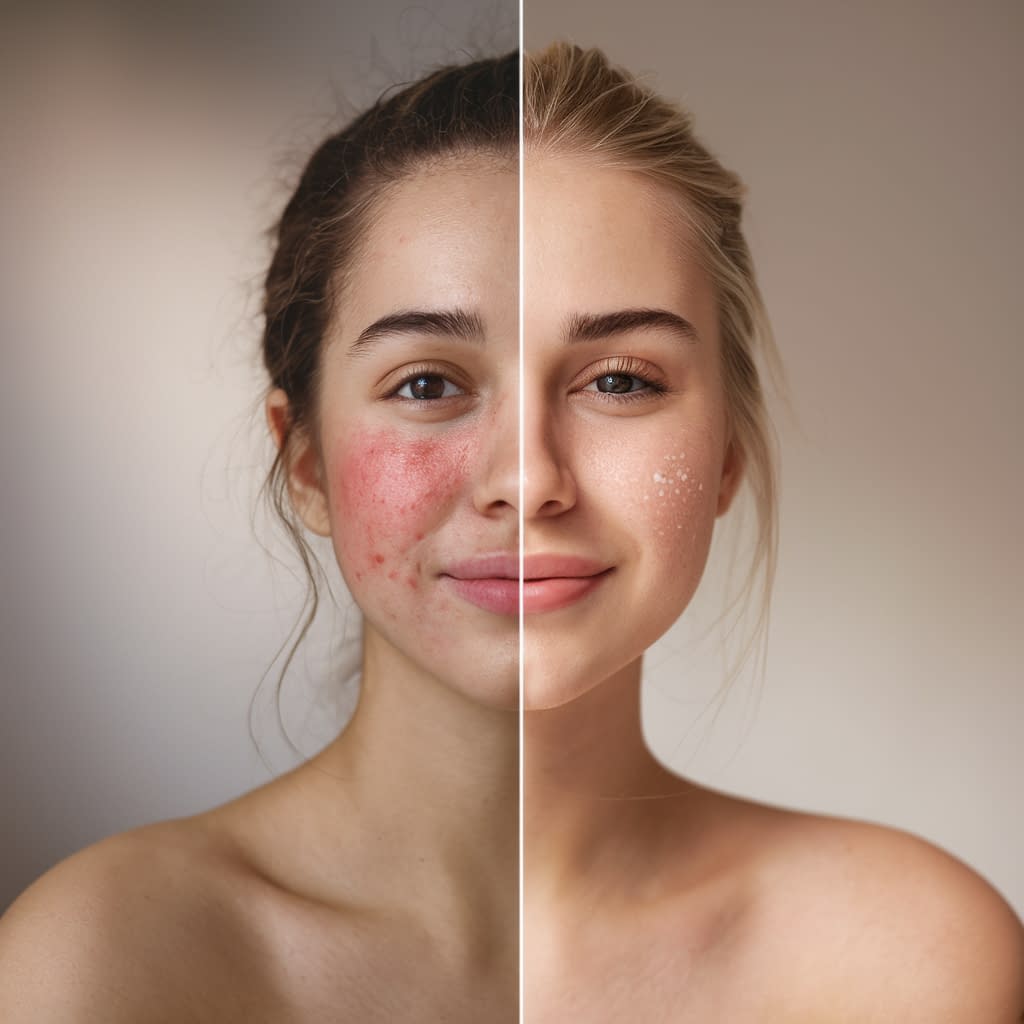
Seek professional help if:
- Redness is persistent, worsening, or spreading, especially with bumps, pustules, scaling, severe burning or stinging.
- You have flushing plus visible blood vessels, or thickening of skin on the nose — signs of rosacea subtype that benefit from medical therapy.
- OTC and gentle care don’t help after 6–8 weeks.
- You suspect steroid-induced redness, or you have scaly plaques that don’t respond to simple care.
What a dermatologist can offer: rule out medical causes, prescribe topical or oral medications (metronidazole, azelaic acid, ivermectin, low-dose doxycycline), light/laser therapies for visible vessels, and tailored patch testing for contact allergy.
Final Words
Let’s wrap with a simple, realistic plan you — and your readers — can follow today:
- Start gentle: stop all potentially irritating products for 2 weeks (fragrance, scrubs, strong acids) and use a simple, hydrating routine.
- Repair the barrier: moisturize twice daily with ceramides and humectants.
- Protect: use SPF 30+ daily and avoid direct sun and extreme heat.
- Use targeted natural soothers: aloe, green tea, colloidal oatmeal — patch test first.
- Lifestyle matters: sleep, hydration, reducing alcohol/spicy triggers, short stress breaks.
- Track triggers: keep a short symptom diary for 2–4 weeks to spot patterns.
- Ask for help early: if redness persists or you see signs of rosacea/infection, consult a dermatologist.
A small, practical 7-day starter plan (copyable)
Day 1–7:
- AM: rinse with lukewarm water → apply hyaluronic serum on damp skin → ceramide moisturizer → SPF 30.
- PM: gentle cleanser → niacinamide serum (2–5%) or centella product → richer ceramide moisturizer.
- Twice this week: green-tea compress or colloidal oatmeal mask for 10–15 min.
- Avoid exfoliants, retinoids, and strong vitamin C for the week. Note any changes.
If redness improves in 2–4 weeks, you can slowly reintroduce single actives one at a time. If not, see a dermatologist.








